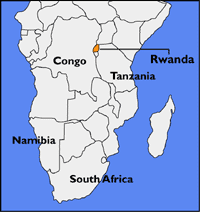|
Rwanda has been called 'a tropical Switzerland in the heart of Africa'. It's about a third the size of Belgium, who administered it from 1919 under a League of Nations mandate (by which it ceased to be part of German East Africa) until independence in 1962. Visitors think it's a beautiful country. ('Beautiful?' said one Rwandan. 'After the things that have happened here?')
Most of the Rwandan population belong to the Hutu ethnic group, traditionally crop-growers. For many centuries Rwanda attracted Tutsis - traditionally herdsmen - from northern Africa. For 600 years the two groups shared the business of farming, essential for survival, between them. They have also shared their language, their culture, and their nationality. There have been many intermarriages.
Because of the nature of their historical pastoral or agricultural roles, Tutsis tended to be landowners and Hutus the people who worked the land; and this division of labour perpetuated a population balance in which Hutus naturally outnumbered Tutsis. A wedge was driven between them when the European colonists moved in. It was the practice of colonial administrators to select a group to be privileged and educated 'intermediaries' between governor and governed. The Belgians chose the Tutsis: landowners, tall, and to European eyes the more aristocratic in appearance. This thoughtless introduction of class consciousness unsettled the stability of Rwandan society. Some Tutsis began to behave like aristocrats, and the Hutu to feel treated like peasants. An alien political divide was born.
European colonial powers also introduced modern weapons and modern methods of waging war. Missionaries, too, came from Europe, bringing a new political twist: the church taught the Hutu to see themselves as oppressed, and so helped to inspire revolution. With the European example before them, and European backing behind them, it was armed resistance that the Hutus chose. In 1956 their rebellion began (it would cost over 100,000 lives). By 1959 they had seized power and were stripping Tutsi communities of their lands. Many Tutsis retreated to exile in neighbouring countries, where they formed the Front Patriotique Rwandais, the Rwandan Patriotic Front (RPF), trained their soldiers, and waited.
After their first delight in gaining power - and, in 1962, independence for Rwanda - a politically inexperienced Hutu government began to face internal conflicts as well. Tensions grew between communities and provincial factions. Tutsi resistance was continually nurtured by repressive measures against them (in 1973, for example, they were excluded from secondary schools and the university). In 1990 RPF rebels seized the moment and attacked: civil war began.
A ceasefire was achieved in 1993, followed by UN-backed efforts to negotiate a new multi-party constitution; but Hutu leaders and extremists fiercely opposed any Tutsi involvement in government. On April 6 1994 the plane carrying Rwanda's president was shot down, almost certainly the work of an extremist. This was the trigger needed for the Hutus' planned 'Final Solution' to go into operation. The Tutsis were accused of killing the president, and Hutu civilians were told, by radio and word of mouth, that it was their duty to wipe the Tutsis out. First, though, moderate Hutus who weren't anti-Tutsi should be killed. So should Tutsi wives or husbands. Genocide began.
|
|
. |

